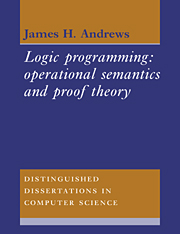4 - Characterising Sequential Systems
Published online by Cambridge University Press: 23 November 2009
Summary
In this chapter, I will give a characterisation of the two inner circles of the Venn diagram in Figure 2.6 in the same way as I characterised the two outer circles. That is, I will give a proof-theoretic characterisation of sequential logic programming (in particular, the operational semantics SP) in the form of a sequent calculus.
For this sequent calculus, we can use the rules LKE from the last chapter unchanged; we need only give anew group of axioms, SEQ, corresponding to PAR from the last chapter. These axioms, however, are more complex than those in PAR, have more side-conditions, and in particular involve the concept of disjunctive unfoldings of formulae.
Nevertheless, we can prove the same things about SEQ that we can about PAR: the laws are sound, and the proof system LKE+SEQ characterises sequential logic programming in several useful ways.
I will also give a characterisation of the last circle in Figure 2.6, namely the middle success circle. This set contains all queries which succeed in SOS/so, and can be characterised by a set of axioms, PASO, which combines axioms from PAR and from SEQ in a simple and intuitively clear way.
Approaches to Semantics
I begin by going into more detail about why we want a semantics for sequential logic programming, and what approaches have been taken so far to giving one.
The assumptions made about search strategies in most research on foundations of logic programming (for instance, SLD-resolution with a fair search rule) are not satisfied by sequential logic programming.
- Type
- Chapter
- Information
- Logic ProgrammingOperational Semantics and Proof Theory, pp. 51 - 70Publisher: Cambridge University PressPrint publication year: 1992



